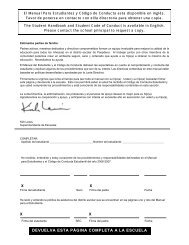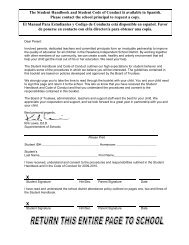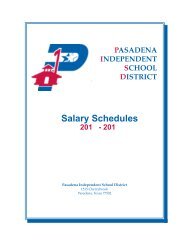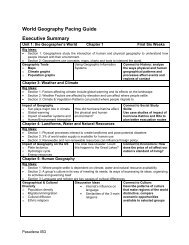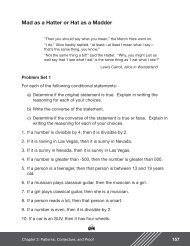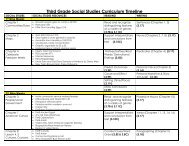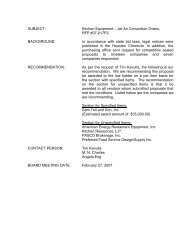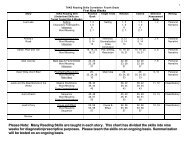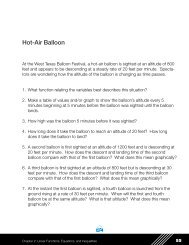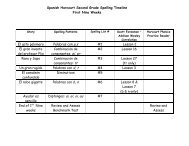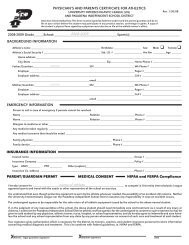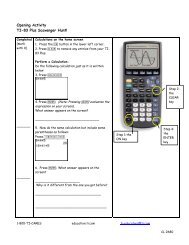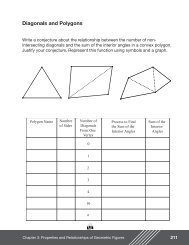Conjecture and Discovery and Proof
Conjecture and Discovery and Proof
Conjecture and Discovery and Proof
You also want an ePaper? Increase the reach of your titles
YUMPU automatically turns print PDFs into web optimized ePapers that Google loves.
<strong>Conjecture</strong> as <strong>Discovery</strong> <strong>and</strong> <strong>Proof</strong> as Explanation<br />
Problem 1<br />
Triangle Midsegment <strong>Conjecture</strong><br />
Use paper, pencil, construction <strong>and</strong> measuring tools<br />
or<br />
appropriate geometry technology to complete this problem.<br />
1. Sketch <strong>and</strong> label a ∆ABC.<br />
2. Find <strong>and</strong> label point D (the midpoint of side AB ) <strong>and</strong> point E (the midpoint<br />
of side AC).<br />
3. Draw midsegment DE.<br />
4. Take <strong>and</strong> record the following measurements in centimeters <strong>and</strong> degrees.<br />
DE = __________<br />
∠ ADE = ________<br />
∠DBC = ________<br />
BC = _____________<br />
∠ AED = __________<br />
∠ECB = ___________<br />
5. Repeat steps 1 – 4 to complete the sketch, <strong>and</strong> take measurements on at<br />
least two more triangles that are different from your original triangle.<br />
If you are working with a group, you may compare your<br />
triangle measurements with the other group members.<br />
If you are using geometry technology, you may drag the vertices of<br />
the original triangle to generate new triangles <strong>and</strong> sets of measurements.<br />
6. Based on your drawings <strong>and</strong> observations, complete the following<br />
conjecture:<br />
H<br />
Chapter 2: Patterns, <strong>Conjecture</strong>, <strong>and</strong> <strong>Proof</strong> 87
The midsegment of a triangle is ____________________________ to<br />
one side of the triangle, <strong>and</strong> it measures _______________________________<br />
of that side.<br />
Problem 2<br />
Why is it true?<br />
If you completed Problem 1, you discovered two important characteristics of<br />
a triangle’s midsegment:<br />
a) The midsegment is parallel to a side of the triangle.<br />
1<br />
b) The midsegment is the length of the side of the triangle<br />
2<br />
it is parallel to.<br />
You might have already known about these properties from previous lessons,<br />
or you might have even guessed what they were without drawing or<br />
measuring. But can you explain why they are true?<br />
In order for your explanation to be fully convincing from a mathematical<br />
st<strong>and</strong>point, it must satisfy three requirements. First, it must be logical.<br />
Second, it must consist of facts, definitions, postulates, or theorems that<br />
have been previously proven or accepted as true. Third, it must apply to<br />
all cases.<br />
Write an explanation of why the first property of triangle midsegments is<br />
true. Your explanation must satisfy all of the above requirements. Use<br />
your knowledge of postulates <strong>and</strong> theorems about parallel lines <strong>and</strong> angle<br />
relationships to help with your explanation.<br />
H<br />
88<br />
Chapter 2: Patterns, <strong>Conjecture</strong>, <strong>and</strong> <strong>Proof</strong>
Problem 3<br />
A Different Look<br />
Mathematicians call explanations similar to the one you wrote in the<br />
previous problem “proofs.” In order to prove the second property about<br />
triangle midsegments, it is helpful to represent the situation in a different<br />
mathematical context.<br />
1. Draw <strong>and</strong> label triangle a ∆ABC on graph paper. Label <strong>and</strong> record<br />
the numerical coordinates of points A, B, <strong>and</strong> C.<br />
2. Use the midpoint formula to find <strong>and</strong> label the following:<br />
point D (the midpoint of segment AB ) <strong>and</strong> point E (the midpoint of<br />
segment AC).<br />
3. Use the distance formula to calculate the length of DE <strong>and</strong> to calculate the<br />
length of BC .<br />
4. What is the relationship between the length of DE <strong>and</strong> the length of BC ?<br />
5. Do the diagram <strong>and</strong> calculations above constitute a proof of the second<br />
property of triangle midsegments? Write a few sentences discussing why<br />
or why not.<br />
H<br />
Chapter 2: Patterns, <strong>Conjecture</strong>, <strong>and</strong> <strong>Proof</strong> 89
Problem 4<br />
The General Situation<br />
Any triangle may be rotated <strong>and</strong> translated so that one vertex is at the origin<br />
<strong>and</strong> another vertex is on the positive x-axis.<br />
y<br />
A<br />
•<br />
( , )<br />
•<br />
•<br />
D( , ) E ( , )<br />
•<br />
B ( , )<br />
C<br />
• x<br />
( , )<br />
1. Fill in the coordinates of points A, B, <strong>and</strong> C in the above diagram using<br />
variables to represent any triangle.<br />
2. Use the midpoint formula to calculate <strong>and</strong> fill in the coordinates of point D<br />
(the midpoint of AB) <strong>and</strong> point E (the midpoint of AC ).<br />
3. Use the distance formula to calculate the length of DE <strong>and</strong> to calculate<br />
the length of BC. Show all work <strong>and</strong> calculations.<br />
4. What is the relationship between the length of DE <strong>and</strong> the length of BC?<br />
5. Do the diagram <strong>and</strong> calculations above constitute a proof of the second<br />
property of triangle midsegments? Write a few sentences discussing<br />
why or why not.<br />
H<br />
90<br />
Chapter 2: Patterns, <strong>Conjecture</strong>, <strong>and</strong> <strong>Proof</strong>
H<br />
Chapter 2: Patterns, <strong>Conjecture</strong>, <strong>and</strong> <strong>Proof</strong> 91
Materials:<br />
Graph paper<br />
One pencil, ruler, protractor per<br />
student <strong>and</strong>/or<br />
Appropriate geometry technology<br />
Connections to Geometry<br />
TEKS:<br />
(b.2) Geometric structure. The<br />
student analyzes geometric<br />
relationships in order to make<br />
<strong>and</strong> verify conjectures.<br />
The student:<br />
(B) makes <strong>and</strong> verifies<br />
conjectures about angles, lines,<br />
polygons, circles, <strong>and</strong> threedimensional<br />
figures, choosing<br />
from a variety of approaches<br />
such as coordinate,<br />
transformational, or axiomatic.<br />
(b.3) Geometric structure. The<br />
student underst<strong>and</strong>s the<br />
importance of logical reasoning,<br />
justification, <strong>and</strong> proof in<br />
mathematics.<br />
The student:<br />
(B) constructs <strong>and</strong> justifies<br />
statements about geometric<br />
figures <strong>and</strong> their properties;<br />
(C) demonstrates what it means<br />
to prove mathematically that<br />
statements are true;<br />
(D) uses inductive reasoning to<br />
formulate a conjecture; <strong>and</strong><br />
(E) uses deductive reasoning to<br />
prove a statement.<br />
(d.2) Dimensionality <strong>and</strong> the<br />
geometry of location. The<br />
student underst<strong>and</strong>s that<br />
coordinate systems provide<br />
convenient <strong>and</strong> efficient ways<br />
of representing geometric figures<br />
<strong>and</strong> uses them accordingly.<br />
92<br />
Teacher Notes<br />
This problem asks the students to investigate <strong>and</strong><br />
then prove important characteristics about a triangle’s<br />
midsegment. The problem, Extending the Triangle<br />
Midsegment <strong>Conjecture</strong>, investigates the midsegment for<br />
other polygons.<br />
Scaffolding Questions:<br />
Problem 1<br />
• Step 1: ∆ABC can be any type of triangle. If students<br />
are working in groups, encourage different group<br />
members to draw different types of triangles.<br />
• Step 3: What is the definition of a triangle’s<br />
midsegment?<br />
• Steps 5 <strong>and</strong> 6: What types of triangles seem to provide<br />
more convincing evidence in support of the conjecture?<br />
Why?<br />
Problem 2<br />
• What type of angles are ∠ADE <strong>and</strong> ∠DBC ?<br />
• What type of angles are ∠AED <strong>and</strong> ∠ECB ?<br />
Problem 3<br />
• Steps 1 – 4: Students will orient their triangles on the<br />
graph paper many different ways <strong>and</strong> will soon find<br />
out that different triangle placements result in “easier” or<br />
“harder” numbers to work with.<br />
• Is it all right to place your triangle on the graph paper in<br />
the most convenient way for the calculations to work<br />
out?<br />
• Step 4: Can you write the relationship as a mathematical<br />
statement?<br />
• Step 5: It can be helpful to point out that in fact the first<br />
two requirements of a mathematical proof have been<br />
fulfilled in this case. The formulas used are accepted<br />
H<br />
Chapter 2: Patterns, <strong>Conjecture</strong>, <strong>and</strong> <strong>Proof</strong>
as true, <strong>and</strong> the diagram as well as the sequence<br />
of calculations constitute the manipulation of symbols<br />
according to logical rules. Many students do not realize<br />
this.<br />
Problem 4<br />
• After problem 3, students will have realized that their<br />
numerical calculations do not constitute a proof.<br />
• What can we replace the numerical coordinates with so<br />
that the calculations will apply to any triangle?<br />
• Why does this particular placement of the triangle make<br />
it easier to fill in the coordinates than other possible<br />
placements?<br />
• What are the fewest number of variables that can be<br />
used to accurately label all the required coordinates?<br />
• Step 2: What could we do to the coordinates of A, B, <strong>and</strong><br />
C to make the calculations easier?<br />
• What effect does multiplying a coordinate variable<br />
by a constant have on subsequent calculations? Is it<br />
mathematically all right to do this?<br />
• Encourage students to simplify the complicated-looking<br />
expressions as much as possible. Review of notation<br />
<strong>and</strong> symbol manipulation under the radical symbol may<br />
be necessary.<br />
The student:<br />
(A) uses one- <strong>and</strong> two-dimensional<br />
coordinate systems to represent<br />
points, lines, line segments, <strong>and</strong><br />
figures; <strong>and</strong><br />
(C) develops <strong>and</strong> uses formulas<br />
including distance <strong>and</strong> midpoint.<br />
(e.3) Congruence <strong>and</strong> the<br />
geometry of size. The student<br />
applies the concept of congruence<br />
to justify properties of figures <strong>and</strong><br />
solve problems.<br />
The student:<br />
(B) justifies <strong>and</strong> applies triangle<br />
congruence relationships.<br />
Texas Assessment of Knowledge<br />
<strong>and</strong> Skills:<br />
Objective 10: The student will<br />
demonstrate an underst<strong>and</strong>ing of<br />
the mathematical processes <strong>and</strong><br />
tools used in problem solving.<br />
Connection to High School<br />
Geometry: Supporting TEKS <strong>and</strong><br />
TAKS Institute:<br />
I. Structure: Midpoint Triangle<br />
Sample Solution:<br />
Problem 1<br />
1 – 5 This is one possible solution.<br />
Length (Segment AD) = 3.26 cm<br />
Length (Segment DB) = 3.26 cm<br />
Length (Segment AE) = 2.83 cm<br />
Length (Segment EC) = 2.83 cm<br />
Angle (ADE) = 59 º<br />
Angle (AED) = 81 º<br />
Angle (DBC) = 59 º<br />
Angle (ECB) = 81 º<br />
A<br />
D<br />
E<br />
B<br />
C<br />
6. The midsegment of a triangle is parallel<br />
to one side of the triangle <strong>and</strong> measures one-half the<br />
length of that side.<br />
H<br />
Chapter 2: Patterns, <strong>Conjecture</strong>, <strong>and</strong> <strong>Proof</strong> 93
Problem 2<br />
A possible axiomatic proof:<br />
A<br />
E<br />
C<br />
D<br />
F<br />
B<br />
Given: D is the midpoint of AB, E is the midpoint of AC .<br />
Prove: DE =<br />
1<br />
BC <strong>and</strong> DE is parallel to BC<br />
2<br />
.<br />
Extend ED to point F such that ED ≅ DF .<br />
AE ≅ EC , AD ≅ DB<br />
∠ADE<br />
≅ ∠BDF<br />
by definition of midpoint<br />
because vertical angles are congruent.<br />
∆ADE<br />
≅ ∆BDF<br />
because two triangles are congruent if two sides <strong>and</strong> the included angle of<br />
one triangle are congruent to two sides <strong>and</strong> the included angle of the other triangle.<br />
∠DBF ≅ ∠A <strong>and</strong> AE ≅ FB because corresponding parts of congruent<br />
triangles are congruent.<br />
AC is parallel to BF<br />
are congruent.<br />
because two lines are parallel if the alternate interior angles<br />
EC ≅ FB<br />
by the transitive property of congruence.<br />
BCEF is a parallelogram because the two sides of the quadrilateral are parallel <strong>and</strong><br />
congruent.<br />
EF = BC because the opposite sides of a parallelogram are equal in length.<br />
FD + DE = BC by segment addition<br />
2 DE = BC by substitution<br />
H<br />
94<br />
Chapter 2: Patterns, <strong>Conjecture</strong>, <strong>and</strong> <strong>Proof</strong>
1<br />
DE = BC by division<br />
2<br />
DE is parallel to BC because opposite sides of a parallelogram are parallel.<br />
This argument applies to the midsegment of any triangle.<br />
Problem 3<br />
One possible coordinate representation:<br />
1 <strong>and</strong> 2.<br />
A (2.0, 4.0)<br />
E (3.5, 3.0)<br />
D (1.5, 2.3)<br />
C<br />
(5.0, 2.0)<br />
B<br />
(1.0, 0.6)<br />
3.<br />
DE = 3.5 -1.5<br />
BC = 5.0 -1.0<br />
1<br />
2<br />
4. DE = BC<br />
2 2<br />
( ) + ( − ) = + ≈<br />
3. 0 2. 3 4 0. 49 2.<br />
12<br />
2 2<br />
( ) + ( − ) = + ≈<br />
2. 0 0. 6 16 3. 7636 4.<br />
44<br />
5. The diagram <strong>and</strong> calculations establish that the midsegment is one-half the length of<br />
the side it is parallel to only for a particular triangle with specific coordinates. They do<br />
not establish that this property is true for the midsegments of all triangles.<br />
H<br />
Chapter 2: Patterns, <strong>Conjecture</strong>, <strong>and</strong> <strong>Proof</strong> 95
Problem 4<br />
For example:<br />
1 <strong>and</strong> 2.<br />
y<br />
A<br />
•<br />
( , )<br />
2n<br />
2p<br />
•<br />
•<br />
D ( n , p ) E ( n+m , p )<br />
•<br />
B<br />
( 0 , 0 )<br />
C<br />
• x<br />
( )<br />
2m, 0<br />
3. DE = ( n + m − n) + ( p − p) = m = | m | = m because m > 0.<br />
4. DE = BC<br />
2 2<br />
BC = ( 2m − 0) + ( 0 − 0) = 4m = | 2m | = 2m<br />
1<br />
2<br />
2 2<br />
2<br />
2<br />
because m > 0.<br />
5. The diagram <strong>and</strong> the calculations do constitute a proof of the second property of<br />
triangle midsegments. The formulas used are accepted as true, <strong>and</strong> the diagram, as<br />
well as the sequence of calculations, constitute the manipulation of symbols according<br />
to logical rules. Finally, using variables instead of specific numbers for coordinates<br />
makes the relationship true for all triangle midsegments.<br />
H<br />
96<br />
Chapter 2: Patterns, <strong>Conjecture</strong>, <strong>and</strong> <strong>Proof</strong>
Extension Questions:<br />
• Write a few sentences detailing why the postulates <strong>and</strong> theorems about parallel lines<br />
<strong>and</strong> angle relationships cannot be used to explain why the second property of triangle<br />
midsegments described in Problem 2 (b) is true.<br />
The postulates <strong>and</strong> theorems about parallel lines <strong>and</strong> angle relationships establish<br />
that lines are parallel given that certain angle relationships are true, or that certain<br />
angle relationships must be true given that parallel lines are cut by a transversal. The<br />
second property of triangle midsegments deals with the relationship between the<br />
lengths of the parallel segments. These postulates <strong>and</strong> theorems don’t provide any<br />
information about the lengths of parallel lines.<br />
• Using the diagram <strong>and</strong> the coordinates from problem 4, prove the first property of the<br />
triangle midsegments: the midsegment of a triangle is parallel to a side of the triangle.<br />
The lines are parallel since it can be shown that they have the same slope.<br />
p − p<br />
Slope of DE = = 0.<br />
n + m − n<br />
0 − 0<br />
Slope of AB = = 0.<br />
2m − 0<br />
H<br />
Chapter 2: Patterns, <strong>Conjecture</strong>, <strong>and</strong> <strong>Proof</strong> 97
Student Work Sample<br />
The work on the next two pages shows a student’s approach to problems 1, 2 <strong>and</strong> 3.<br />
This work is a good example of the criteria<br />
• Uses geometric <strong>and</strong> other mathematical principles to justify the reasoning used to<br />
analyze the problem.<br />
In problems 2 <strong>and</strong> 3, this student explains his reasons for the statements he makes.<br />
(Since line a is the midsegment of triangle B, it bisects AB <strong>and</strong> AC….).<br />
• Makes an appropriate <strong>and</strong> accurate representation of the problem using correctly<br />
labeled diagrams.<br />
Note that the student does not explain how he got the measurements.<br />
H<br />
98<br />
Chapter 2: Patterns, <strong>Conjecture</strong>, <strong>and</strong> <strong>Proof</strong>
H<br />
Chapter 2: Patterns, <strong>Conjecture</strong>, <strong>and</strong> <strong>Proof</strong> 99
H<br />
100<br />
Chapter 2: Patterns, <strong>Conjecture</strong>, <strong>and</strong> <strong>Proof</strong>



